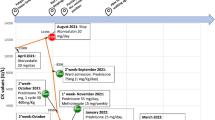Summary
In a study undertaken to investigate the relationship between vibration syndrome and collagen disease, 90 Japanese patients with vibration syndrome (all men aged 41–86 years) were examined immunologic abnormalities, mainly by a set of immunoserology tests. Of these 90 patients, 25 had examinations at yearly intervals for 3 consecutive years, while the other 65 underwent examinations once. The results indicate that, of all the patients studied, 10 (11.1%) gave a positive RA test, 6 (6.7%) had leukopenia, 5 (5.6%) had hypergammaglobulinemia, and 15 (16.7%) had hypocomplementemia (CH50). Worthy of particular note are the 21 patients (23.3%) who were positive for nuclear-specific antibodies (1: ≥ 40) (using Hep-2 cells as the nuclear substrate), with some of them suspected of having Sjögren's syndrome, progressive systemic sclerosis, or systemic lupus erythematosus. During a 3-year follow-up period, 10 (40%) of 25 patients exhibited rising titers of nuclear-specific antibodies with conversion to seropositivity for these antibodies. The facts that the positivity rate for nuclear-specific antibodies was significantly higher in these patients with vibration syndrome (23.3%) than in healthy adult men over 40 years of age (1.8%) (P < 0.05) and that a progressive elevation of nuclear-specific antibody titer was noted in a high percentage of the patients were suggestive of some causal relationship between the appearance of nuclear-specific antibodies and the use of vibrating tools.
Similar content being viewed by others
References
Blair HM, Headington JT, Lynch PJ (1974) Occupational trauma, Raynaud phenomenon, and sclerodactylia. Arch Environ Health 28:80–81
Bramwell B (1914) Diffuse sclerodermia: its frequency; its occurrence in stone-masons; its treatment by fibrolysin-elevations of temperature due to fibrolysin injections. Edinb Med J 12:387–401
Harada N, Hirosawa I, Dodo H, Hosokawa M, Asagami C (1981) A case of progressive systemic sclerosis in construction workers — on the effect of exposed vibration at winch operating. Jpn J Ind Health 23:164–165
Jones RN, Turner-Warwick M, Ziskind M, Weill H (1976) High prevalence of antinuclear antibodies in sandblasters' silicosis. Am Rev Respir Dis 113:393–395
Lange A (1980) An epidemiological survey of immunological abnormalities in asbestos workers. Environ Res 22:162–175
Leys D (1939) Diffuse scleroderma and Raynaud's phenomenon from the use of a pneumatic hammer. Lancet II:692
Lippmann M, Eckert HL, Hahon N, Morgan WKC (1973) Circulating antinuclear and rheumatoid factors in coal miners. A prevalence study in Pennsylvania and West Virginia. Ann Intern Med 79:807–811
Maeda M, Ichiki Y, Mori S, Horai T (1988) Microvibration test under vibration and cold stresses in PSS. Jpn J Dermatol 98:9–13
Matsumoto Y, Kawabe M, Yasue T, Yuguchi M, Yoshida I (1989) Two cases of scleroderma associated with vibration syndrome. Jpn J Dermatol 99:155–161
Soutar CA, Turner-Warwick M, Parkes WR (1974) Circulating antinuclear antibody and rheumatoid factor in coal pneumoconiosis. Br Med J 3:145–147
Author information
Authors and Affiliations
Rights and permissions
About this article
Cite this article
Matsumoto, Y., Yasue, T., Miyagawa, H. et al. An immunoserological study of patients with vibration syndrome. Int. Arch Occup Environ Heath 63, 537–539 (1992). https://doi.org/10.1007/BF00386342
Received:
Accepted:
Issue Date:
DOI: https://doi.org/10.1007/BF00386342




